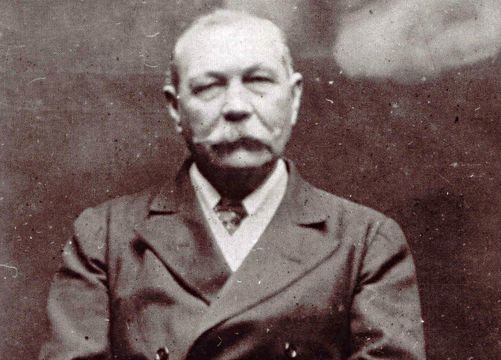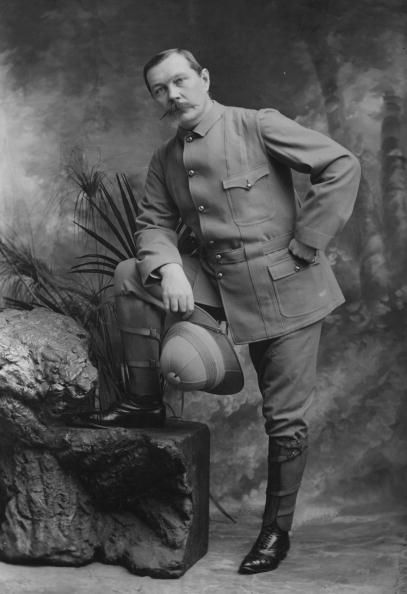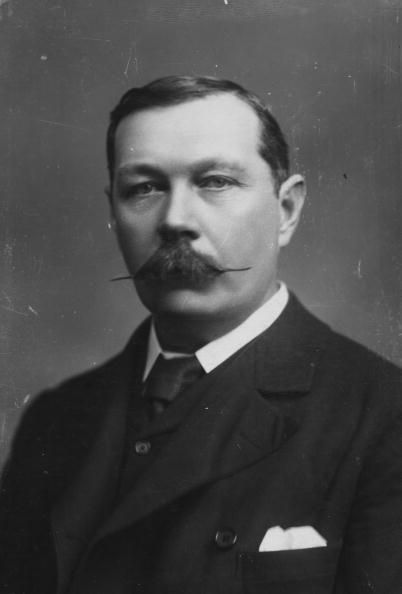
Sir Arthur Conan Doyle.Occult World / Flickr / CC
We celebrate the legacy of Arthur Ignatius Conan Doyle, the wonderful author behind Sherlock Holmes and his own great fight for justice.
Savvy Londoners know that there is no such address as 221B Baker Street to be found anywhere in the city. It requires less intimate knowledge of London to know that the famous lodger at this non-existent address, the Consulting Detective Sherlock Holmes, is equally fictitious. Yet even today the Royal Post Office receives letters addressed to the literary detective at the imaginary address, sent by people claiming to have been wrongfully accused of some crime, and asking Holmes' help in solving the case.
In the early years of the 20th century, however, one such desperate man penned a more practical letter, addressing it not to Sherlock Holmes, but to his creator, Sir Arthur Conan Doyle, who, events would prove, shared many of Holmes' special talents.
Read more
George Edalji
The petitioner was George Edalji, the 27-year-old son of the vicar of Great Wyrley. Edalji's story began even before he was born, when his father, a man of Parsee ancestry, married an Englishwoman, converted to Christianity, and ultimately became the spiritual leader of his small Staffordshire community. His parishioners, perhaps thinking that the elder Edalji's Parsee heritage made him an unsuitable Christian preacher, had little liking for him, and at least one of them made he and his wife's lives miserable. In 1892, when George was 16 years old, the Edaljis began receiving threatening letters in the post. At the same time, other Staffordshire clergymen received abusive letters over Edalji's forged signature, earning him the hatred of his peers. Mocking advertisements appeared in local newspapers, also purporting to be submitted by the disliked vicar. George shared in the family's troubles, seemingly earning someone's special resentment by becoming a successful solicitor with a fine professional reputation.

Arthur Conan Doyle
The harassment directed against the Edalji family came to a head following several incidents of animal mutilation throughout Great Wyrley. In the wake of these incidents, the police received anonymous letters accusing George Edalji of the crimes. The local Chief Constable not only acted on the accusation but also reasoned that George had written the mysterious correspondence himself. This all fitted in with his long-held belief that George had been the one responsible for the earlier threatening letters that had been sent to his father.
Acting on his suspicions, the Chief Constable assigned no less than six policemen to keep the Edalji house under surveillance. Despite this, a labourer heading to work in the early hours of a summer's day stumbled upon another mutilated animal, a pony this time, whose stomach had been sliced open.
The police already preconditioned to believe George Edalji was the culprit, investigated the scene hastily, then returned to the vicarage to arrest the preacher's son. By this time, George had already left for work, so the investigators searched the house and confiscated a pair of muddy shoes, a pair of pants with dirt around the cuffs, and various other clothes on which they found blood and horsehair. With these items in their custody, the police then proceeded to George's Birmingham office, where they arrested their suspect.
The evidence
If the evidence collected at the vicarage looked damning superficially, the police showed a remarkable lack of interest in reasoning out the facts of the case to a logical conclusion. When studied in detail, the evidence was far from convincing. George's whereabouts during the previous evening were corroborated by several witnesses who placed him far from the crime scene. George had then retired for the night at 9.30. He slept in the same room as his father, who locked the door to the bedroom each night. The elder Edalji swore that his son could never have left the room after 9.30.
Presuming, however, that he was able to slip past his father and out of the room, he would then have had to sneak undetected past all six of the policemen who were watching the house, and then repeat this feat of stealth on the return trip. This is exactly what the police alleged had happened, and George Edalji was tried on 20th October 1903, found guilty, and sentenced to seven years in jail. In addition, the verdict effectively destroyed his law career.
Outrage
The injustice of the sentence was obvious to many outside Great Wyrley. Ten thousand people signed a petition demanding that the case be retried. Newspapers carried stories upholding Edalji's innocence as well, but to no avail until the third year of his sentence, when he was released without pardon, apology, or explanation.
In an effort to clear his name, Edalji wrote his own version of the incident, which was published in The Umpire. Subsequently, he posted a clipping of the article to Arthur Conan Doyle. 'As I read,' Sir Arthur remembered, 'the unmistakable accent of truth forced itself upon my attention, and I realized that I was in the presence of an appalling tragedy and that I was called upon to do what I could to set it right.'
At the time, Conan Doyle was grieving over the death of his wife and perhaps questioning whether he had done all that he might to make her last days as comfortable as possible. If so, the Edalji case came to his attention at a time when he was acutely conscious of both of his own responsibilities and the consequences of taking a cavalier attitude toward someone in need. He launched himself into a personal investigation of the case with the same enthusiasm with which Holmes might shout, 'Come, Watson, the game is afoot!'
Conan Doyle gets involved
He began by studying Edalji's own account of the case. As he did so, several questions came to mind. Painstakingly, he wrote to everyone involved in the case who might be able to shed light on some of the oddities he perceived in George's description of the evidence and the trial. His investigation turned up some very startling defects in the case against Edalji. The razor that the police claimed the defendant used to mutilate the pony had contained not a trace of blood. The mud found on Edalji's clothes was of a completely different type of soil than that found at the crime scene. Most absurdly, Conan Doyle learned that the police had wrapped a piece of the dead horse's hide, taken for evidence, in Edalji's clothes, thus accounting for the hair that had been found on them. As to the small traces of blood on the same clothes, Sir Arthur commented that 'The most adept operator who ever lived would not rip up a horse with a razor upon a dark night and have only two threepenny-bit spots of blood to show for it. The idea is beyond all argument.'
After he had convinced himself beyond any doubt that George Edalji did not commit the crime, he arranged to meet the man in person. When he did, his first impression confirmed all his previous conclusions, for it immediately became apparent that Edalji suffered from a condition that Conan Doyle had not previously suspected. 'I had been delayed,' Conan Doyle recalled later, 'and he was passing the time by reading the paper... He held the paper so close to his eyes and rather sideways, proving not only a high degree of myopia but marked astigmatism. The idea of such a man scouring fields at night and assaulting cattle while avoiding the watching police was ludicrous to anyone who can imagine what the world looks like to eyes with the myopia of eight dioptres.' Edalji's eyes not only gave Sir Arthur further proof of their owner's innocence, but they also provided a possible explanation of why the police may have been predisposed to suspect him. His inability to focus his eyes gave him an odd distracted look that could easily be interpreted as sinister.
Conan Doyle submitted the complete results of his investigations to The Daily Telegraph on 9th January 1907, with instructions to clearly label it as copyright-free, so that other papers could pick up the story and spread the news. 'Only an appeal to the public can put an end to a course of injustice and persecution which amount, as I hope that I shall show, to a national scandal', Sir Arthur advised. The newspaper obliged, printing the entire 18,000-word summary in two parts.

Arthur Conan Doyle
Finding the killer
With Edalji by this time freed from jail, another man may have felt that nothing further needed to be done, but Conan Doyle was outraged by the government's refusal to acknowledge any fault or to pay Edalji any compensation for having his career and three years of his life taken from him through such a careless exercise of the criminal justice system. His report was as much an indictment of the police as a vindication of Edalji, charging the authorities with race prejudice, incompetence, and deliberate deceit.
In the meantime, Conan Doyle had turned his attention to an as-yet-unasked question: If Edalji was innocent, then who had committed the crime? Sir Arthur's crusade on Edalji's behalf clearly represented a threat to the mysterious slasher, and before long Conan Doyle received one of the threatening letters that had so long plagued the vicar of Wyrley. 'Think of all the ghoulish murders that are committed,' the note read. 'Why then should you escape?' The recipient treated the letter not so much as a warning as another piece of evidence, again turning to the Telegraph and the public for help. The 29th May edition contained another letter from Sir Arthur, stating: 'Upon Monday, the 27th, I received a letter and a postcard, both unstamped, from the unknown correspondent whose writing runs right through the whole Edalji affair from 1892 onwards... A crease in both documents seems to show...that they may have been sent up undercover, or possibly in somebody's pocket--a railway guard or other--and then posted. Should this be so one might hope to follow them back to the writer, and I hereby offer a reward of L20 to anyone who will enable me to say for certain whence they came.'
In the event, Detective Doyle found the crucial clue himself in a subsequent letter sent by the anonymous correspondent. The second missive contained a scathing remark about a former headmaster of the Walsall Grammar School in Staffordshire. Conan Doyle remembered that one of the letters sent to the senior Edalji had contained a similar reference and that a stolen key from the school had once turned up on Edalji's doorstep. Sir Arthur contacted the ex-schoolmaster and asked if he could think of anyone who had attended the school and might have reason to hold such an unfavourable opinion of him. The schoolmaster suggested a boy whom he had expelled years before for uncontrollable, destructive behavior.
Providing the evidence
Conan Doyle further learned that in the years since the boy had become a butcher and that a friend of his family remembered seeing him with a lancet at about the time of the animal mutilations. Once he was on the right track, Sir Arthur found many more coincidences that identified the butcher as the guilty party beyond any possible doubt.
Conan Doyle provided all this evidence to the three-man commission, which deliberated and then concluded that Edalji had not, in fact, killed the horse and should, therefore, be pardoned, but that he had 'to some extent brought his troubles on himself', so there would be no compensation. By this, the commission apparently referred to the threatening letters, which it still believed Edalji had written to his father.
Conan Doyle's response, again in the form of a letter to the Telegraph, was predictable. 'While the friends of Mr. George Edalji rejoice that his innocence has at last been admitted (though in the most grudging and ungracious fashion), they feel that their work is only half done so long as compensation is refused him. It is clearly stated in the report of the Committee that: 'The police commenced and carried on their investigations, not for the purpose of finding out who was the guilty party, but for the purpose of finding evidence against Edalji, who they were already sure was the guilty man.'
'The result has proved that he was not the guilty man, and this inversion of all sane methods upon the part of the police has given untold mental agony to himself and to his family, has caused him to undergo the ordeal of the double trial, three years of incarceration, and an extra year of police supervision. Apart from the misery which has been unjustly inflicted upon him, he has been unable to exercise his profession during that time and has been put to many heavy expenses, which only the self-sacrifice of his relations has enabled him to meet. And now, though all these results have been brought about by the extraordinary conduct of the police, and the stupidity of a Court of Quarter Sessions, the unfortunate victim is told that no compensation will be made him.'
The Home Office responds
All of this evidence, however, was of interest only to the news press. The Home Office replied simply that a decision had already been reached, and that was that. No action was ever taken against the man Sir Arthur had convincingly proven was responsible for both the threatening letters and the animal mutilations--as well as for stealing the key to the local grammar school. The Law Society, showing markedly better judgment than either the police or the government, permitted George Edalji to resume his legal practice, but Sir Arthur's great investigative success ended on a bitter note. The government bureaucracy, he concluded in disgust, is motivated by 'a determination to admit nothing which inculpates another official, and as to the idea of punishing another official for offenses which have caused misery to helpless victims, it never comes within their horizon.'
A later biographer of Sir Arthur Conan Doyle rendered an even harsher verdict: 'Doyle thought that the Home Office was insane to ignore the evidence he had placed in their hands, but in expecting reason and justice from bureaucrats his own sanity was open to doubt.' Certainly, it was not the kind of ending a Sherlock Holmes fan would have expected.
* Originally published in June 2006.





Comments